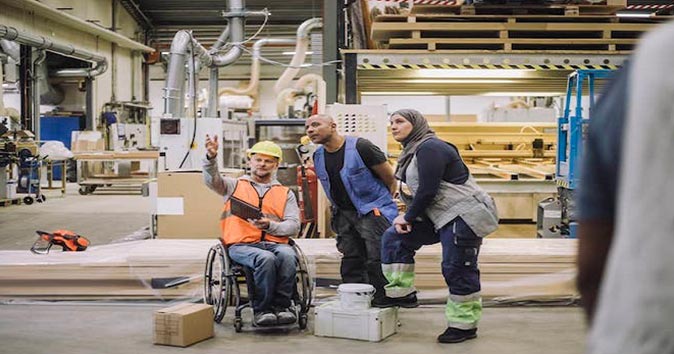How to Combat Ableism in the Workplace

One in four adultsOpens in a new tab (27%) in the United States has some form of physical or intellectual disability. And yet, ableism is pervasive throughout workplaces in 2023. Many companies have outdated policies and attitudes that aren't accessible or welcoming for employees with a disability.
Even if your organization considers themselves to be inclusive, there is still work to be done. Keep reading to find out how to combat ableism in the workplace.
What is ableism in the workplace?
Ableism is discrimination against people with disabilities that can be distilled down to the belief that non-disabled people are more capable and better than disabled people. It others people with disabilities and implies that people with disabilities should or can be "fixed."
Ableism shows up in the workplace in both obvious and subtle ways. For example, scheduling a meeting in a building that isn't handicap accessible should be obvious, while not scheduling enough breaks during the meeting might be more subtle.
It can be systemic and individual. Your company might not offer any flexible work schedules, which would be a systemic issue, but if an employee requests it to support their abilities and it's denied, that would be an individual challenge.
Ableism can be conscious or unconscious. Interviewing candidates and assuming an able-bodied person would be a better candidate or unconsciously choosing to interview candidates without disabilities are both examples of ableism.
The good news is that the more companies educate themselves on disability awareness, the better they will be at catching these forms of discrimination and preventing them from happening again. Observing disability month is a meaningful way to amplify this education and foster awareness across the organization.

Understanding the impact
21% of people with a disability in the US are employed. This is the highest employment rate since 2008, and economists believe this is due to the widespread adoption of remote work and accessible technologies.
It's important to be mindful that disability isn't always visible. 62% of people with disabilities in the white-collar workforce have an invisible disability that you wouldn't know about unless they told you. And disability isn't always chronic – an employee might be dealing with a temporary injury or illness.
Research has found that one-third of people with disabilities indicated that they had experienced negative bias in the workplace, such as "feeling underestimated, insulted, excluded, or had coworkers appear uncomfortable because of their disability.”
Beyond making work difficult, inaccessible, and unpleasant for workers with a disability, an ableist workplace culture perpetuates the employment and pay gaps that affect workers with disabilities.
Further reading: How to promote inclusion in the workplace
Benefits of addressing ableism
Addressing ableism in the workplace will only produce positive changes in your company. After making an intentional and conscious effort to be a more inclusive workplace, you'll likely notice:
- improved employee morale
- stronger team dynamics
- greater innovation
- access to a widened talent pool
- enhanced diversity, inclusion, and belonging metrics
- increased productivity
- decreased turnover

Strategies for confronting ableism
To create a truly inclusive environment, your organization needs to band together to fight ableism. Let's talk through the actions your company can take to make progress towards becoming an anti-ableist organization.
Create inclusive hiring policies
To get started, review your hiring processes and standards. Ensure you aren't using any technology that might filter out resumes of candidates with disabilities who have had gaps in their employment. Make sure that your job applications are accessible to all and that you are advertising jobs in places and forums that will help you hire people with disabilities.
Here are some small changes you can make to your hiring processes that will make a big difference:
- list only absolutely necessary requirements in a job description (for example, "applicant must be able to lift a certain weight")
- provide alternative ways to apply
- make it clear on a job posting that you offer remote and asynchronous work
- reference disabilities in the Equal Employment Opportunity Statement
And continue to make positive changes after the recruitment process. Ensure that your company is offering benefits packages that support the wellness of employees with disabilities. Additionally, make sure that your onboarding is intentional and inclusive of people with disabilities.
You might also like: The value of belong at work
Rethink productivity
Your goal should be to create an environment that supports both productivity and the unique needs of employees with disabilities. Instead of measuring productivity in a traditional way, ask yourself: what do our employees need?
Providing each employee with their specific accommodations is a great way to ensure that they can do their best work. Ensure that you are communicating effectively so your employees know it's okay to request any changes that will make their work easier to get done.

Build in accessibility and accommodations
It's a common misconception that accommodations cost companies a lot of money. A survey found that 49% of employers who provided cost information reported the accommodations they made cost absolutely nothing to implement ($0).
Keeping in mind that employees may be managing a chronic, invisible, or temporary disability, organizations should provide reasonable, built-in, and normalized accommodations for all employees. This should help ensure that all people feel safe and comfortable using accommodations when and how they need to, without disclosing private health information.
Companies can incorporate accessibility and accommodations like the below:
- ensuring there are breaks in long meetings
- setting core hours for meetings
- allowing employees to work from home without formal approval
- making it clear that brief, flexible leave (a few hours at a time) for employee wellness is accepted
- providing access to change equipment or technology
See also: Remote Workforce Accommodations for Employees with Disabilities
Educate HR, leadership, and employees
Knowledge is power. This is especially true when creating an anti-ableist workplace. Educating executives, leadership, and individual contributors about accessibility, unconscious biases, and disabilities in general will help to create a more inclusive work environment.
The Employer Assistance and Resource Network on Disability Inclusion (EARN) suggests adopting a recognition program to acknowledge employees for achieving progress and furthering their education towards an anti-ableist workplace. Consider using a tool like Workhuman's Social Recognition that allows peer-to-peer appreciation and thanks.
Provide employee training on inclusive language
Ableist language at work can perpetuate stereotypes and exclude individuals with disabilities. A lack of awareness around commonly used ableist metaphors and slurs is part of the problem.
Here are some terms and phrases that should be avoided:
- "Fall on deaf ears" or "Are you deaf?"
- Lame or dumb
- "I'm so OCD!" or "I'm so ADHD right now!"
- "It's like the blind leading the blind."
- Crazy or insane
Instead, we should focus on inclusive language for the workplace. This means focusing on both people-first language (a person with X disorder) and identity-first language (a deaf person). It depends on the individual which they prefer, so encourage employees to check in with each other if they aren't sure how to address someone.
Both leaders and employees should gently correct someone's language if they hear a microaggression or exclusive language being used.
Monitor corporate language
Again, the power of inclusive language is imperative to creating an anti-ableist culture. It's important to review internal and public documents and media to replace stigmatizing terms with inclusive alternatives.
Consider posting the company’s policy statements regarding disability inclusion and accommodations on your website. Include information on internship, mentoring, and job shadowing opportunities along with your recruitment and hiring initiatives.

Provide equal opportunities for advancement
Ensure that your company is providing fair advancement opportunities for all employees by eliminating common barriers like bias and favoritism. To do this, companies can build out structured and intentional career pathing programs, create opportunities for shadowing, development and mentorship programs, provide networking opportunities, and invest in employee resource groups.
FAQs
What is the difference between ableism and discrimination?
Discrimination – unjust or prejudicial behavior towards different categories of people – is a form of ableism, like sexism or racism. Ableism views non-disabled people as more capable than disabled people.
What is ableism in the workplace?
Ableism in the workplace is when a disabled worker is treated or viewed as less than a non-disabled person. It can present itself in verbal and nonverbal communication, workplaces that aren't accommodating to needs, or looking at a disabled person as needing to be "fixed".
Generally, it could show up as a lack of workplace adjustments, physical barriers that prevent someone from doing their best work, microaggressions, or treating an employee with disabilities in a biased or different way.
Conclusion
Eliminating ableism in the workplace should be a priority for your organization. Education and awareness from the top down are key to creating a truly inclusive and anti-ableist workplace.
Rethinking hiring, productivity, internal and external language, and accommodations will position your company for success in supporting and developing all employees.
About the author
Alicyn Zall
Alicyn Zall is a writer dedicated to creating a more equitable and fulfilling workplace. With a focus on actionable, data-driven insights, her work empowers individuals and organizations to foster positive change. In addition to her contribution at Workhuman, Alicyn has served as an editor at Harvard Business Review where she developed books and articles about mental health and the future of work.